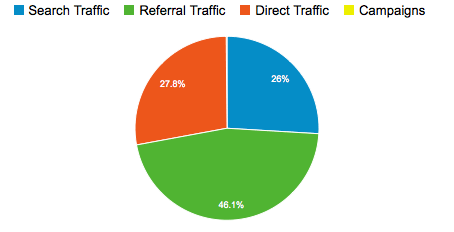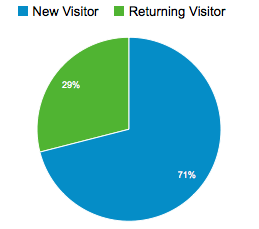Even though generic blog challenges and opportunities may not exist, I think that most blogs probably share around 80% of these goals. And just to be clear, by blogs I don't mean corporate blogs with their specific requirements (sales, leads, conversions), but modern online magazines, originally (and still) called blogs, even though they are actually becoming mainstream media. Therefore, this analysis can work for most online publishers, but I'm doing it mostly to help me understand what I need to do to reinvent my blog again. It's pretty simple: getting and retaining traffic. All other requirement are derived from these two.
Main goal: getting traffic, increasing engagement
The main goal of every website is to get traffic. For traffic, you need great (or at least good) content, something with added value for the users. What you do with that traffic, is another story. Sell things, sell ads, sell yourself.
There are primarily three different sources of traffic you can receive: direct, referral and search. You want all of them, and each component is a result of different activities. Getting direct traffic means you have a strong brand. Getting referral traffic means you have great writers / influencers which help you get backlinks to your blog. Getting search traffic means you have a great technical team and SEO (CMO and SMO) optimized site.

You want a well-balanced stream of traffic to your blog.
The other important goal that websites have is keeping the traffic on the site, which can be done by stimulating user engagement. Helping things happen after you get people to your blog. You want users to spend as much time as possible with you, navigate through many pages, and hopefully give you some feedback - leaving comments and sharing your posts on social media. Some blogs want other actions as well, but these are probably the most obvious ones.
Increasing social media activity
Social media is emerging as one of the most important referral sources. But lately, it's becoming a noteworthy factor for search engine rankings as well. That's why blogs are trying hard to integrate social media widgets into their content, some even go beyond the standard tweet / like / + 1 buttons. Help people share, there are many benefits from it, both direct and indirect.

The social activity on my most visited post. These figures translate into more than 10k unique users.
Lowering bounce rates, increasing time on site
Most blogs have very high bounce rates - people tend to read a single post and leave the site. That is why designers and information architects are trying to do everything to keep readers on their site, hoping to persuade them to read another article. Some are trying too hard by adding too many related posts, others are playing with many interesting ways of driving readers to the next page.
My current bounce rate is more than 80%, with average visit duration just above 2 minutes. Something that needs to be improved urgently. I am sure this will be one of the most significant challenges I will face when developing the next generation of my blog.

Improving these bounce rates and time on site is one of my highest priorities.
Treating every page as a landing page
The time when people visited the homepage and navigated further from there are over. Today, specially because of social media, every page is a landing page and needs to be treated as such. We are consuming content in a different way, we don't browse for content anymore, the content finds us. That is why we need to design every single page as the starting point for our visitors.
At this point, less than 10% of traffic to my blog comes through the homepage. Which means designing great post pages is becoming more important than designing the homepage, since every page needs to become a hub for further navigation.
Building loyalty and credibility (branding)
Besides keeping users on site, it's also important you get users back to the site. As your brand and reputation evolve, it gets easier with all of the traffic components, but you can achieve that with only one thing - great content. Of course, nice design and user experience help, but you can't bypass this simple fact: you need something with added value to the readers. Only then you will get loyal users and only then your blog will thrive.

Even though most focus is done on gaining new readers, you mustn't forget about returning ones.
Allowing a mobile-friendly experience
We are living in a mobile world and more and more traffic is made by mobile devices. This number is closing in on 20% on my blog, which means optimization for mobile visitors is becoming something that you can't ignore.

Mobile operating systems are on the rise.
Combining it with the funky new UI elements
In my previous post, I outlined the interesting new user interface elements my favourite blogs use. Now we can map these elements with the above mentioned five challenges and opportunities, which will help us understand the requirements behind the innovations.
| Social media | Bounce / time | Landing pages | Branding | Mobile |
|---|
| Unconventional navigation | | 1 | 1 | 1 | |
| Fixed (floating) menu | | 1 | 1 | | |
| Responsive design | | 1 | | 1 | 1 |
| Big key visual before text | 1 | 1 | | | |
| Advanced key visual (gallery, video) | 1 | 1 | | 1 | |
| Abstract, teaser, subheading | 1 | | | | 1 |
| Suggested content within limits | | 1 | 1 | | 1 |
| Custom social media integration | 1 | | | 1 | |
| Polished content (wrapping, quotes) | 1 | 1 | | 1 | |
| Custom typography | | | | 1 | |
| Infinite scroll | | 1 | | | 1 |
| Pinterest-style homepage | | 1 | | 1 | |
| Integrated content and navigation | | 1 | 1 | 1 | |
| Total | 5 | 10 | 4 | 8 | 4 |
It's pretty clear each of the elements has at least one specific goal that it's trying to solve. Some of them will surely become a standard in the future.
Conclusion
What a modern blog is trying to achieve in 2013 is pretty clear. Get more traffic, make users spend more time on the site. This hasn't changed in decades, but the behaviour of the users has. Only those that will be able to adapt to the newly-formed situation will survive.
The most important paradigms that have shaped the past years are the social and mobile era, which have revolutionized the ways we consume content. We are online all the time, with many devices, and there is so much content everywhere, it's overwhelming. Our attention span is becoming very limited, and all of above mentioned challenges are focused in trying to capture it.
I decided it's time to redesing my blog again, and by understanding what (and why) the market leaders do, my task will surely be easier. I hope you find my analysis useful, but please feel free to add anything I may have forgotten in the comments.
Check out the complete Reinventing the blog series.